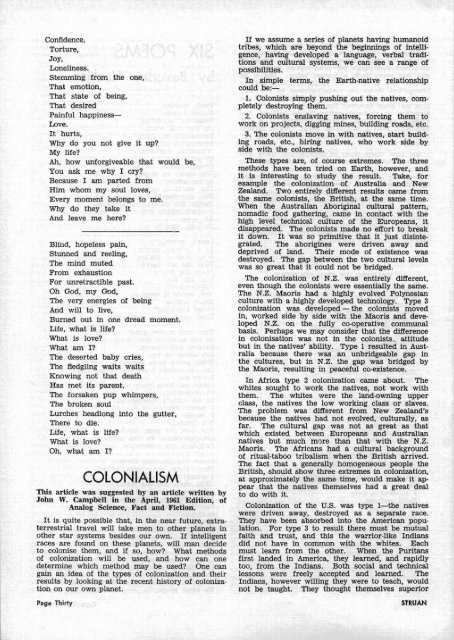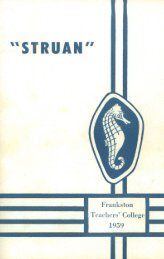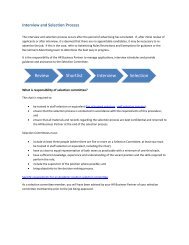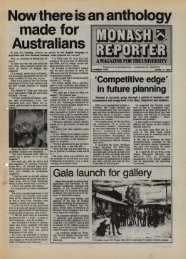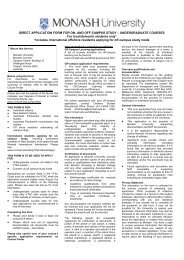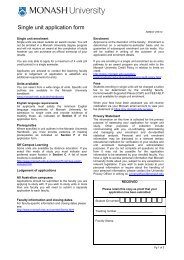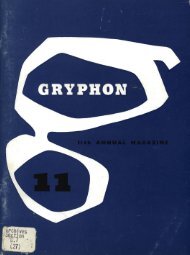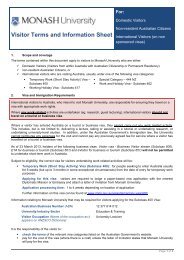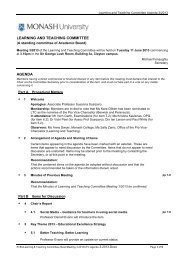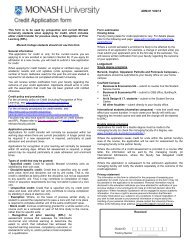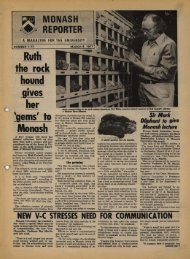Confidence,Torture,Joy,Loneliness.stemming from the one,That emotion,That state of being,That desiredPainful happinessLove.It hurts,Why do you not give it up?My life?Ah, how unforgiveable that would be ,You ask me why I cry?Because I am parted fromHim whom my soul loves,Every moment belongs to me .Why do they take itAnd leave me here?Blind, hopeless pain,Stunned and reeling,The mind mutedFrom exhaustionFor unretractible past.Oh God, my God,The very energies of beingAnd will to live,Burned out in one dread moment.Life, what is life?What is love?What am I?The deserted baby cries,The fledgling waits waitsKnowing not that deathHas met its parent.The forsaken pup whimpers,The broken soulLurches headlong into the gutter,There to die.Life, what is life?What is love?Oh, what am I?COLONIALISMThis article was suggested by an article written byJohn W. Campbell in the April, <strong>1961</strong> Edition, ofAnalog Science, Fact and Fiction.It is quite possible that, in the near future, extraterrestrialtravel will take men to other planets inother star systems besides our own. If intelligentraces are found on these planets, will man decideto colonise them, and if so, how ? What methodsof colonization will be used, and how can onedetermine which method may be used? One cangain an idea of the types of colonization and theirresults by looking at the recent history of colonizationon our own planet.Page ThirtyIf we assume a series of planets having humanoidtribes, which are beyond the beginnings of intelligence,having developed a language, verbal traditionsand cultural systems, we can see a range ofpossibilities.In simple terms, the Earth-native relationshipcould be:1. Colonists simply pushing out the natives, completelydestroying them.2. Colonists enslaving natives, forcing them towork on projects, digging mines, building roads, etc .3. The colonists move in with natives, start buildingroads, etc., hiring natives, who work side byside with the colonists.These types are, of course extremes. The threemethods have been tried on Earth, however, andit is interesting to study the result. Take, forexample the colonization of Australia and NewZealand. Two entirely different results came fromthe same colonists, the British, at the same time.When the Australian Aboriginal cultural pattern,nomadic food gathering, came in contact with thehigh level technical CUlture of the Europeans, itdisappeared. The colonists made no effort to breakit down. It was so primitive that it just disintegrated.The aborigines were driven away anddeprived of land. Their mode of existence wasdestroyed. The gap between the two cultural levelswas so great that it could not be bridged.The colonization of N.Z. was entirely different,even though the colonists were essentially the same.The N.Z. Maoris had a highly evolved Polynesianculture with a highly developed technology. Type 3colonization was developed - the colonists movedin, worked side by side with the Maoris and developedN.Z. on the fully co-operative communalbasis. Perhaps we may consider that the differencein colonisation was not in the colonists.. attitudebut in the natives' ability. Type 1 resulted in Australiabecause there was an unbridgeable gap inthe cultures, but in N.Z. the gap was bridged bythe Maoris, resulting in peaceful co-existence.In Africa type 2 colonization came about. Thewhites sought to work the natives, not work withthem. The whites were the land-owning upperclass, the natives the low working class or slaves.The problem was different from New Zealand'sbecause the natives had not evolved, culturally, asfar. The cultural gap was not as great as thatwhich existed between Europeans and Australiannatives but much more than that with the N.Z.Maoris. The Africans had a cultural backgroundof ritual-taboo tribalism when the British arrived.The fact that a generally homogeneous people theBritish, should show three extremes in colonization,at approximately the same time, would make it appearthat the natives themselves had a great dealto do with it.Colonization of the U.S. was type I-the nativeswere driven away , destroyed as a separate race. 'They have been absorbed into the American population.For type 3 to result there must be mutualfaith and trust, and this the warrior-like Indiansdid not have in common with the whites. Eachmust learn from the other. When the Puritansfirst landed in America, they learned, and rapidlytoo , from the Indians. Both social and technicallessons were freely accepted and learned. TheIndians, however willing they were to teach, wouldnot be taught. They thought themselves superiorSTRUAN
to the "immigrants". The Maoris were willing toteach . . . and be taught.You must respect a man to learn from him. Youdo not have to respect a man to teach him. Thetest of mutual respect turns out to be mutual learning-and-teaching.When this exists men can worktogether. When it doesn't, there can be no cooperativeendeavour. The fault lies with the sidethat will not learn. The American Indians werepushed out by the whites because co-existenceproved impossible. The Indians would not learn.The Eskimo has learned to co-exist. Though notsocially developed, he needs to be technically welldeveloped to survive in his environment. TheEskimo has learnt a number of mechanical skillsfrom the white man, while the whites have learntto survive in the Arctic.It would appear, then, that whether colonizationtype, 1, 2 or 3 is used depends far more on thecharacter of the natives than on the determinationor choice of the colonists. It was not a Britishpolicy to enslave local natives only an Africanarea policy. The same British acted differentlyin Australia and N.Z., because the natives weredifferent. When colonists go into an area whether it be a continent or alien planet-wherethe natives are too far below the cultural levelof the colonists, the natives will be pushed aside.If the cultural level is somewhat higher, theywill be enslaved and this I feel finally results indestruction of the colony and a rise in the culturaland living standards of the ensl aved natives asfor instance in Ghana.The cultural level being not too much differentthe colonists and natives will fall into the thirdpattern, mutual teaching and learning, and establisha hybrid culture such as exists in N.Z., Hawaii andAlaska.If and when the time comes, will man colonisethe planets sensibly? Perhaps the opposite mayoccur. How would you react if Earth was invadedvisitedby beings socially and technically superior?Peter Jack .ICEBERG -Beverley HockingSomewhere between the supreme idealist, on theone hand, and the nonchalant semi-realist, on theother, lay such a personality as Wilbur Steinhardt.Just where he stood was never quite clearto his acquaintances. The inferior respected himwithout being quite sure why; the superior declinedto display their superiority vaguelyhaunted by the uncertainty of his postion: couldhe perhaps be their superior?To converse with Wilbur Steinhardt left onewith the uneasy feeling that perhaps he was secretlyamused by one 's ideas, one's troubles. Butoffence could never logically be taken for onecould never be quite sure. Indeed, it was thisvery uncertainty which gave him his power. Forhe undoubtedly did have power! Not that heshowed it. Far from it, for Wilbur Steinhardtlived a very humble existence. But again therewas the impression that this perhaps was nothis natural station. Quietly spoken, he was withmanners almost to perfection-yet not quiteforhe could sometimes be quite abrupt. Yes,almost, but not positively, might some peopleaccuse him of a momentary rudeness.Wilbur Steinhardt was neither tall nor short.He might be called solid, but never fat, andevery part of him he wore with dignity (even tothe slightly greying hairs which bordered his recedinghair-line). Usually he was to be seen witha hat on his head, and an umbrella over hisarm, his hat conspicuously clean, his umbrellaperhaps a trifle used.It was on just such an occasion that we sawhim that day-his familiar hat slightly tilted tothe left , his umbrella swaying gently on his leftarm. We had nodded on recognition, passed on,and thought no more about it (that is, we hadnot thought aloud about it, only to ourselves,for one could not help but wonder about theman). We had talked about the weather. "ISTRUANthought that it would rain yesterday," and"Hasn't it been a lovely day?" We had observedthat the world was in a state of uncertainty;that the children up the street had measles; andthat the dog simply had to have a new collar. Allsuch omnipotent observations being dutifully dealtwith, we had wished each other a goodnightand escaped to the confusion of our homes, whereintelligent and pleasant conversation might giveway to non-committal grunts from behind thenewspaper, or boisterous, assertive commentsabout nothing in particular.As I ate , I imagined what he would be doing.He would be eating a humble meal as he satin his lonely room. But how could he bear thesolitude? Of what, or whom, would he bethinking? He would read. Yes, that was a certainty.And then? Perhaps he would sleep, but. . . I wonder . . . Somehow I felt that in theprivacy of his room an unseen observer mightwitness a rebellion, a struggle, as his mind andemotions fought to escape from the tightly boundunemotional guise which he had adopted for theoutside world. Perhaps in the tomb-like silenceof the night he would struggle to prevent hismind from dwelling on some haunting, hiddenepisode which had driven him here. Was thismere conjecture on my part, or had some smallincident concerning him jarred on my mind andmade me think thus?The next time we saw him was with her. Ofcourse we had all wondered about his past life :where had he come from, and why he livedalone. There were rumours, too, but you don'tbelieve everything you hear. And now she hadcome. We were sure that she had some holdover him, but we could never think what itmight be. We saw the change come over him,not slowly as you might expect one to change,but frighteningly, all too swiftly and devastatingly.That calm, that apparent self-assurance, was noPage Thirty-one


